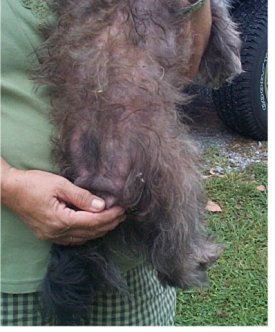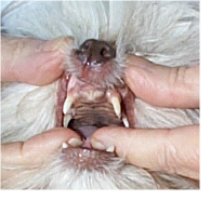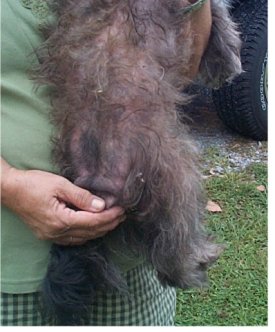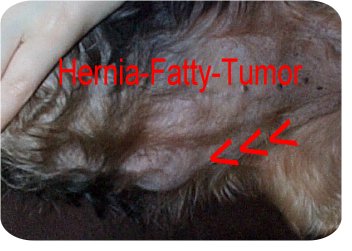Canine Cushings Disease Symptoms
Canine Cushings disease or Cushing’s syndrome is known in the veterinary field as hyperadrenocorticism.
This condition is one of the most commonly diagnosed canine endocrine disorders. Cushing’s arises from the overproduction of glucocorticoid, hormones produced by the adrenal gland.
These hormones regulate protein, carbohydrate and fat metabolism; and are essential to every function of the cells and organs. This makes Cushing’s a very complicated disease with many symptoms and causes. Cushing’s is seen mostly in middle aged to older pets and can be mistaken for the aging process.
While 85% of all cases of Cushing’s are caused by a pituitary gland tumor there are three specific causes, with all three having the same symptomology.

Senior dog health
Pituitary gland tumor - This is the most common cause of this syndrome (85% of all cases). The tumor can be benign or malignant. The tumor causes the pituitary to overproduce a hormone, stimulating the adrenal glands.
This results in the excessive secretion of cortisone. Even a microscopic tumor can cause this overproduction. As a general rule, if the activity of the adrenal gland can be controlled a large number of these dogs can lead a life with a normal lifespan.
Adrenal gland tumor – Another cause of Cushing’s, these tumors also can be benign or malignant. With adrenal tumors it is found that 50% are benign, leaving the other 50% malignant in nature. When a benign tumor is found to be the cause, surgery to remove the tumor can cure the disease. If a malignant tumor is found surgery is still an option, however the prognosis is less favorable.
Iatrogenic – Iatrogenic Cushing’s Disease is caused by an excess administration of cortisone. This administration can be oral or injected for a number of reasons. While the original administration had legitimate reasons, the excess then becomes detrimental. This form of Cushing’s is fully reversible by slowly withdrawing the external source of steroids, allowing the adrenals to resume functioning on their own.
Canine health problems
The symptoms associated with canine Cushings disease progress slowly in most cases. There is a classic combination of symptoms and lesions that develop with all Cushings sufferers. A study showed that most dogs diagnosed had at least one symptom for one to six years prior to being diagnosed.
These symptoms occur so gradually that owners often attribute them to old age. With some pets there will be only one symptom present while others may have many.
Symptoms of Canine Cushings Disease
Increased water consumption and urination: This is the most common symptom associated with Cushing’s. The dog may drink between two and ten times the normal amount of water and the increased urination follows. This symptom is present in 85% of dogs with Cushing’s. This can cause previously housebroken pets to begin having accidents due to rapidly filling bladders.
Increase in appetite: This affects 80% of pets diagnosed with Cushing’s. Dogs may steal food, beg continuously, raid the garbage and/or become protective of their food. This increase in appetite may lead owners to believe their pet is fine because of the good appetite.
Abdominal enlargement: This symptom is also evident in 80% of dogs with Canine Cushings Disease. This potbellied appearance is due to the shifted fat to the abdominal area and a wasting and weakening of muscle mass in the abdomen.
Hair loss and thin skin: Of dogs diagnosed with Cushing’s, hair loss is the primary reason owners bring their pets to the vet. It is estimated that between 50 and 90% of pets are affected with hair loss and a thinning of the skin.
The hair loss typically begins in high wear areas such as the elbows and progresses to the flanks and abdomen. Eventually only the head and extremities have hair present. The skin can become thin, thus easily damaged and difficult to heal.
Symptoms of cushings disease
Several other possible symptoms can include increased panting, recurring urinary tract infections and loss of reproductive ability.
There is no single test that can diagnose Cushing’s. When suspected, the initial examination should include a complete blood count, blood chemistry panel and urinalysis. These tests, while not enough to confirm a diagnosis, can point a veterinarian in the right direction towards further testing.
Treatment can consist of several options based on the cause and progression of the disease. If an adrenal tumor is identified, surgery can be an option based on the form of tumor present.
Non surgical treatment is the treatment most often used in canine Cushings disease. There are currently several different oral medications being used to treat Cushing’s. A veterinarian can determine the most effective form of treatment for your pet.
Canine Cushings Disease to Canine Kids
Canine Cushings Disease to Dog Health Info













